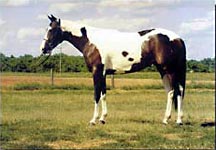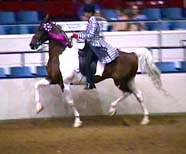

Pinto


Introduction: If you have any comments or suggestions, please click here.
Names: Pinto, from the Spanish pintado, meaning painted. There is also a Paint; these are two different things. The Pinto is a color breed, and the Paint is an actual breed. There is a very true saying that all Paints are Pintos, but not all Pintos are Paints!
Origin: Favorite
horse of the Comanche tribe was the Paint or Pinto. The Comanches were the
buffalo hunters of the Great Plains, unsurpassed in horsemanship, and the
Pinto--a fast, agile, and durable plains pony--was the ideal mount for running
buffalo. Its coloration, too, pleased the Comanche braves; in fact, if a
horse's markings were not bold enough, it might be touched up with paint or
dye. When cattle raising spread over the Great Plains, the talents of the
Pinto, as well as its stylish looks, were much in demand by cowboys. The
Paint cow pony might bring $50 more than a solid-color horse of comparable
quality.
Pintos are bred in the United States and have been recognized
as a breed since 1963. Color is the standard that defines these horses, though, of course,
to be registered an individual must also have sound conformation.
Breeding: The distinctive coloration of the Pinto is the result of a genetic strain that causes white areas combined with red or black areas on the skin. It reproduces consistently. Breeders believe this strain is an ancient one, citing the Pintos painted more than 3,000 years ago on the walls of Egyptian tombs. Now, after many decades of neglect, the breed is getting plenty of attention. Like the Appaloosa in the Sixties, it seems ready to "take off."
Description: A Pinto is any horse or pony which exhibits the black-and-white or brown-and-white coloration known otherwise as piebald or skewbald, respectively. In Britain especially, the latter terms are the only ones used to designate such blotch-colored horses. Feral horses or ponies often display a "pinto" coloration, and horses of such coloring were common among the mustangs, Indian ponies, and the once-great herds that overran the South American pampas. Various patterns of coloration in Pinto horses and ponies are recognized by certain reed associations; but the Pinto horse is not a breed but a color type.
Body: One source stated that Pintos tend to have thick necks set on heavy shoulders. This may be based on an opinion of Pintos as Quarter Horse types, with fairly heavy builds--often, but not always, true.
Color: The
ideal pattern is 50/50 between white and some other color; the minimum amount of
marking acceptable in a horse with just one spot is an area equal to 75 square
inches and this must be visible when the horse is standing normally.
Pintos are described as overo or tobiano. Overo
horses are marked with white on a basically colored coat; tail and mane are dark
or mixed. A tobiano horse is basically white with markings in a
darker color; mane and tail are the same color as neck and rump.
Two
marking types: overo--white areas begin on underside and extend upward in
an irregular pattern; tobiano--white starts on back and spreads downward
usually in a regular pattern.
Either "Overo," that is, piebald (black/white), or
"Tobiano," skewbald--white with
any color except black.
I am not certain about anything, but I am pretty sure the
last one is wrong. Piebald and skewbald are just that, the difference in
color; overo and tobiano are differences in pattern. My guess is that the
first two can go together and the last one needs to be taken out. However,
I will leave everything until I am certain!
Size: Various heights.
Temperament:
Features:
Uses: Used for riding and herding.
Accomplishments:
Curiosities: The two-colored Pintos were also popular with the Indians for their built-in camouflage.
Profiles:
Conclusion: